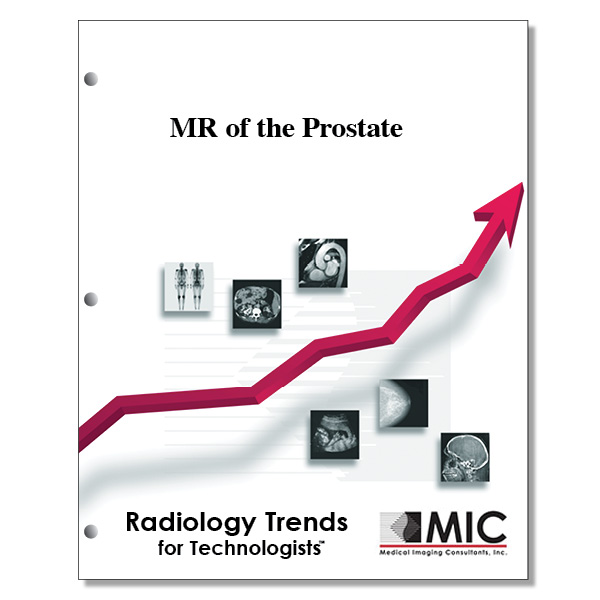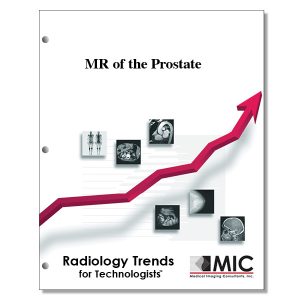

MR of the Prostate
A review of the newest MR imaging techniques and their role in the localization and staging of prostate cancer.
Course ID: Q00336 Category: Radiology Trends for Technologists Modalities: MRI, Nuclear Medicine4.75 |
Satisfaction Guarantee |
$39.00
- Targeted CE
- Outline
- Objectives
Targeted CE per ARRT’s Discipline, Category, and Subcategory classification for enrollments starting after June 11, 2024:
[Note: Discipline-specific Targeted CE credits may be less than the total Category A credits approved for this course.]
Computed Tomography: 0.75
Procedures: 0.75
Abdomen and Pelvis: 0.75
Magnetic Resonance Imaging: 4.50
Image Production: 1.25
Physical Principles of Image Formation: 0.25
Sequence Parameters and Options: 0.50
Data Acquisition, Processing, and Storage: 0.50
Procedures: 3.25
Body: 3.25
Nuclear Medicine Technology: 1.50
Procedures: 1.50
Endocrine and Oncology Procedures: 1.50
Registered Radiologist Assistant: 4.00
Procedures: 4.00
Abdominal Section: 4.00
Sonography: 1.50
Procedures: 1.50
Abdomen: 1.50
Radiation Therapy: 2.25
Patient Care: 1.50
Patient and Medical Record Management: 1.50
Procedures: 0.75
Treatment Sites and Tumors: 0.75
Outline
- Introduction
- Clinical Background and Specific MR Imaging Considerations
- Prostate Cancer Screening
- Transrectal US and Guided Biopsy
- Role of MR Imaging in Screening, Localization, and Biopsy
- Staging of Prostate Cancer
- Anatomy, Histologic Features, and Morphologic Imaging of the Prostate
- Imaging Anatomy of the Prostate
- Grading of Prostate Cancer with the Gleason System
- Morphologic Imaging with T2-weighted and T1-weighted Sequences
- Staging of Prostate Cancer with Morphologic Imaging
- Diffusion-weighted Imaging and ADC Mapping
- MR Spectroscopy
- Dynamic Contrast-enhanced MR Imaging
- Prostate MR Imaging at 3T versus 1.5T
- MR Imaging-guided Biopsy
- Development of an Imaging Algorithm
- Summary
Objectives
Upon completion of this course, students will:
- recognize what percentage of all cancers in males are prostate cancers
- understand that the prevalence of prostate cancer increases with age, and that up to 70% of men 80 years and older have histologic evidence of prostate cancer
- realize that the 5 year survival rate for all stages of prostate cancer has been increasing for the last 25 years, and is now almost 99%
- know the local, minimally invasive options available for cancer confined to the prostate
- know the three dimensions in the accurate assessment of prostate cancer
- know what markers are currently used for prostate cancer screening
- know the lifetime risk of a diagnosis of prostate cancer for men
- know the risk of death from prostate cancer
- recognize what is considered clinically significant prostate cancer
- know what percentage of patients with mild elevation of PSA have the increased levels as a result of a benign condition
- know the definition of prostate density
- know the percentage of prostate cancers that are isoechogenic to normal parenchyma
- know the recommended time for repeat prostate biopsy after an initial biopsy is indicated by abnormal PSA levels, or other abnormal finding
- be familiar with the volume of the prostate gland that is extracted during a biopsy session
- compare transperineal with transrectal biopsy of the prostate
- know which method of prostate evaluation can provide spatial information about prostate cancer
- know what percentage of prostate cancers are underestimated by clinical staging
- know why MRI is ideally suited for evaluation of the prostate
- identify the MRI contrast agent that allows detection of almost all pathologically involved lymph nodes
- know the zonal anatomy of the prostate
- know which type of cancer makes up 95% of prostate cancers
- be familiar with the appearance of the capsule of the prostate on T2-weighted images
- understand the anatomy of the prostate and how it allows cancer to spread outside the prostate
- know how many grades make up the final Gleason score
- know the lowest Gleason score for cancer in the United States
- understand the value of T1-weighted imaging for the prostate
- know some criteria for extracapsular extension of prostate cancer
- know reasons for reduced diffusion in prostate cancer
- know that ADC is reduced in prostate cancer and by how much, compared to normal tissues
- understand what DWI reflects at high b-values
- be able to characterize lower b-value DWI images
- be familiar with the reason for increased ADC values in aging males
- list some reasons for susceptibility-induced distortions on DWI
- know the units for expressing chemical shift
- be able to name the chemical solution used as a reference for the null point in MR spectroscopy
- understand why adequate saturation bands around the prostate are important in MR spectroscopy
- be able to name two MR spectroscopic methods
- know the classic MR spectral signature of prostate cancer
- understand the behavior of prostate cancer during dynamic contrast-enhanced MR studies
- list tumor types that can be difficult to detect due to partial volume effect
